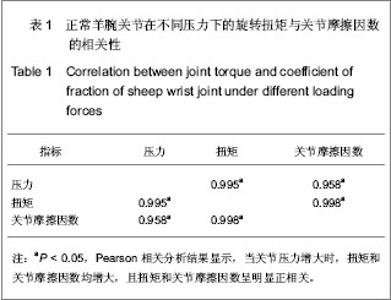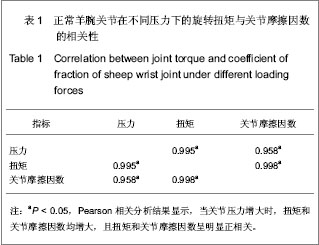Chinese Journal of Tissue Engineering Research
Previous Articles Next Articles
Biomechanical measurement system for measuring frictional properties of synovial joint after cartilage injury
Mu Yi-ping1, Otto Muller2, Nicolas Wullker2
- 1 Feng Tian Hospital Affiliated to Shenyang Medical College, Shenyang 110024, Liaoning Province, China
2 Tuebingen University, Baden-Wuerttemberg Tuebingen 72076, Germany
-
Received:2013-04-27Revised:2013-05-30Online:2013-06-25Published:2013-06-25 -
Contact:Nicolas Wullker, Doctor, Professor, Tuebingen University, Baden-Wuerttemberg Tuebingen 72076, Germany NicolasWullker@live.com -
About author:Mu Yi-ping☆, Doctor, Attending physician, Feng Tian Hospital Affiliated to Shenyang Medical College, Shenyang 110024, Liaoning Province, China yiping.mu@163.com
CLC Number:
Cite this article
Mu Yi-ping, Otto Muller, Nicolas Wullker. Biomechanical measurement system for measuring frictional properties of synovial joint after cartilage injury[J]. Chinese Journal of Tissue Engineering Research, doi: 10.3969/j.issn.2095-4344.2013.26.012.
share this article
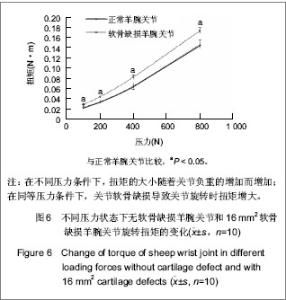
2.1 样本数量分析 实验共纳入10只羊腕关节,不分左右,均进行了生物力学测试。满足了方差分析的样本数量。全部样本均完成了生物力学测试,所有实验数据全部纳入统计分析。 2.2 正态分布检验 取400 N压力条件下的扭矩及关节摩擦因数,经K-S检验,P > 0.05,说明所得数据符合正态分布,可以进行组间方差分析。 2.3 不同压力下羊腕关节扭矩的变化 当无软骨缺损时,羊腕关节在100,200,400,800 N压力状态下,旋转的扭矩大小分别为:0.021 7,0.031 7,0.063 0,0.145 0 N•m,4种压力状态下,羊腕关节旋转扭矩大小比较差异有显著性意义(P < 0.05)。 在软骨缺损面积为16 mm2时,羊腕关节在100,200,400,800 N压力状态下,旋转的扭矩大小分别为:0.027 0,0.041 7,0.080 6,0.172 4 N•m,4种压力状态下,软骨缺损羊腕关节旋转扭矩大小比较差异亦有显著性意义(P < 0.05)。同等压力状态下,正常羊腕关节的旋转扭矩较软骨缺损时的旋转扭矩明显减小(P < 0.05),见图6。"
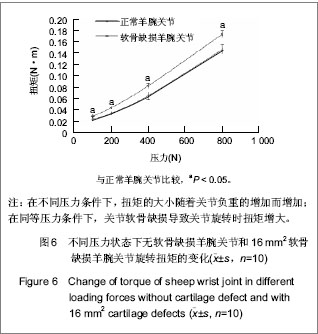
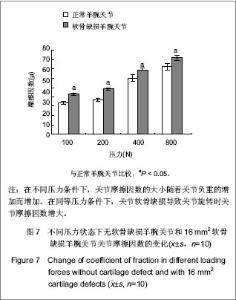
2.4 不同压力下羊腕关节关节摩擦因数的改变 正常羊腕关节的关节摩擦因数(μ)随着关节压力的增加而增大(P < 0.05),在100,200,400,800 N压力状态下,关节摩擦因数分别为:0.006 7,0.007 3,0.012 0和0.014 5。 同样,当软骨缺损出现时,随着纵向压力的增加,关节摩擦因数逐渐增大(P < 0.05),在100,200,400,800 N压力状态下,软骨缺损羊腕关节的关节摩擦因数(μ)分别为:0.008 6,0.009 7,0.013 7和0.016 4。 在同等压力条件下,正常羊腕关节关节摩擦因数明显低于软骨缺损羊腕关节的关节摩擦因数(P < 0.05),见图7。"
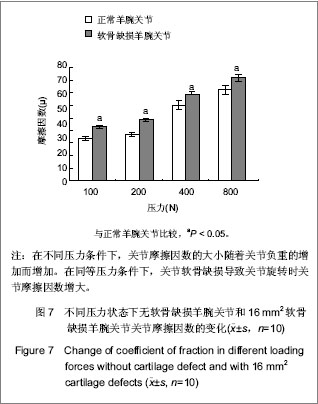
| [1] Koonce RC, Bravman JT. Obesity and osteoarthritis: more than just wear and tear. J Am Acad Orthop Surg. 2013;21(3): 161-169.[2] Thomsen J, Straarup T, Danielsen C, et al. No effect of risedronate on articular cartilage damage in the Dunkin Hartley guinea pig model of osteoarthritis. Scand J Rheumatol. In press.[3] Krasnokutsky S, Samuels J, Abramson SB. Osteoarthritis in 2007. Bull NYU Hosp Jt Dis. 2007;65(3):222-228.[4] Hinton R, Moody RL, Davis AW, et al. Osteoarthritis: diagnosis and therapeutic considerations. Am Fam Physician. 2002;65(5):841-848.[5] Hao W, Mu YP. Linchuang Fangshexue Zazhi. 2012;31(11): 1641-1644.郝崴,牟怡平.透明质酸钠对骨性关节炎疗效评价的T_2 mapping方法实验研究[J].临床放射学杂志,2012,31(11): 1641-1644.[6] Hori Y, Kato K. Studies on tribology. Proc Jpn Acad Ser B Phys Biol Sci. 2008;84(8):287-320.[7] Dowson D. Bio-tribology. Faraday Discuss. 2012;156:9-30, 87-103.[8] Taylor RI. Tribology and energy efficiency: from molecules to lubricated contacts to complete machines. Faraday Discuss. 2012;156:361-382, 413-434.[9] Panjwani B, Sinha SK. Tribology and hydrophobicity of a biocompatible GPTMS/PFPE coating on Ti6Al4V surfaces. J Mech Behav Biomed Mater. 2012;15:103-111.[10] Spencer ND. Tribology. Faraday Discuss. 2012;156:435-438.[11] N'guessan HE, Leh A, Cox P, et al. Water tribology on graphene. Nat Commun. 2012;3:1242.[12] Noble P, Lumay G, Coninx M, et al. A pendulum test as a tool to evaluate viscous friction parameters in the equine fetlock joint. Vet J. 2011;188(2):204-209.[13] Pritzker KP, Gay S, Jimenez SA, et al. Osteoarthritis cartilage histopathology: grading and staging. Osteoarthritis Cartilage. 2006;14(1):13-29.[14] Rieker CB. Tribology considerations for hip joint articulations in relation to the "new orthopaedic patient". Hip Int. 2006;16 Suppl 4:12-16.[15] Liu F, Chen Z, Gu Y, et al. Deformation of the Durom acetabular component and its impact on tribology in a cadaveric model--a simulator study. PLoS One. 2012; 7(10):e45786.[16] Teeple E, Fleming BC, Mechrefe AP, et al. Frictional properties of Hartley guinea pig knees with and without proteolytic disruption of the articular surfaces. Osteoarthritis Cartilage. 2007;15(3):309-315.[17] Crisco JJ, Blume J, Teeple E, et al. Assuming exponential decay by incorporating viscous damping improves the prediction of the coefficient of friction in pendulum tests of whole articular joints. Proc Inst Mech Eng H. 2007;221(3):325-333.[18] Jay GD, Torres JR, Rhee DK, et al. Association between friction and wear in diarthrodial joints lacking lubricin. Arthritis Rheum. 2007;56(11):3662-3669.[19] Neu CP, Komvopoulos K, Reddi AH. The interface of functional biotribology and regenerative medicine in synovial joints. Tissue Eng Part B Rev. 2008;14(3):235-247.[20] Baryshev SV, Erck RA, Moore JF, et al. Characterization of surface modifications by white light interferometry: applications in ion sputtering, laser ablation, and tribology experiments. J Vis Exp. 2013;(72):e50260.[21] Fineberg J. Tribology: Diamonds are forever - or are they? Nat Mater. 2011;10(1):3-4. [22] Gotsmann B. Tribology: Sliding on vacuum. Nat Mater. 2011; 10(2):87-88.[23] Nosonovsky M, Bhushan B. Green tribology. Philos Trans A Math Phys Eng Sci. 2010;368(1929):4675-4676.[24] Nosonovsky M, Bhushan B. Green tribology: principles, research areas and challenges. Philos Trans A Math Phys Eng Sci. 2010;368(1929):4677-4694.[25] Kumar D, Daniel J, Biswas SK. Tribology of steel/steel interaction in oil-in-water emulsion; a rationale for lubricity. J Colloid Interface Sci. 2010;345(2):307-315.[26] Ou J, Wang J, Liu S, et al. Tribology study of reduced graphene oxide sheets on silicon substrate synthesized via covalent assembly. Langmuir. 2010;26(20):15830-15836.[27] Gleghorn JP, Jones AR, Flannery CR, et al. Boundary mode lubrication of articular cartilage by recombinant human lubricin. J Orthop Res. 2009;27(6):771-777.[28] Schmidt TA, Gastelum NS, Nguyen QT, et al. Boundary lubrication of articular cartilage: role of synovial fluid constituents. Arthritis Rheum. 2007;56(3):882-891.[29] Eltawil NM, De Bari C, Achan P, et al. A novel in vivo murine model of cartilage regeneration. Age and strain-dependent outcome after joint surface injury. Osteoarthritis Cartilage. 2009;17(6):695-704.[30] Mastbergen SC, Marijnissen AC, Vianen ME, et al. The canine 'groove' model of osteoarthritis is more than simply the expression of surgically applied damage. Osteoarthritis Cartilage. 2006;14(1):39-46.[31] Yuan Q, Kan WB, Song PF, et al. Influence of Bushen Huoxue decoction on beta-catenin, MMP-7 of synoviocytes in rats with knee osteoarthritis. Zhongguo Gu Shang. 2012;25(9): 761-765.[32] Zhang CX, Sun L, Xiu ZB. Effects of pilose antler polypeptide on the glycosaminoglycan and type II collagen in experimental knee osteoarthritis. Zhongguo Gu Shang. 2012;25(2):138-142.[33] Zhang Q, Lv Hh, Chen A, et al. Efficacy of infliximab in a rabbit model of osteoarthritis. Connect Tissue Res. 2012; 53(5): 355-358.[34] Cheng T, Zhang L, Zhao XL, et al. Jiepou Xuebao. 2012;43 (4):540-544.程潭,张柳,赵小林,等.兔实验性骨性关节炎早期软骨下骨板的变化[J].解剖学报,2012,43(4):540-544.[35] Chu M, Sun LS, Jiang Q. Zhongguo Weichuang Waike Zazhi. 2012;12(7):659-663.储淼,孙立胜,蒋青.不同年龄兔前交叉韧带切断后关节软骨变化的研究[J].中国微创外科杂志,2012,12(7):659-663.[36] Yang RF, Hu YY, Wu YS, et al. Zhongguo Jiaoxing Waike Zazhi. 2006;14(19):1497-1499.杨瑞甫,胡蕴玉,吴银松,等.兔骨性关节炎两种动物模型的比较[J].中国矫形外科杂志,2006,14(19):1497-1499.[37] Intema F, DeGroot J, Elshof B, et al. The canine bilateral groove model of osteoarthritis. J Orthop Res. 2008;26(11): 1471-1477.[38] Intema F, Sniekers YH, Weinans H, et al. Similarities and discrepancies in subchondral bone structure in two differently induced canine models of osteoarthritis. J Bone Miner Res. 2010;25(7):1650-1657.[39] Mastbergen SC, Marijnissen AC, Vianen ME, et al. Inhibition of COX-2 by celecoxib in the canine groove model of osteoarthritis. Rheumatology (Oxford). 2006;45(4):405-413.[40] Lorenz A, Rothstock S, Bobrowitsch E, et al. Cartilage surface characterization by frictional dissipated energy during axially loaded knee flexion-An in vitro sheep model. J Biomech. 2013; 46(8):1427-1432.[41] Shen W, Chen J, Zhu T, et al. Osteoarthritis Prevention Through Meniscal Regeneration Induced by Intra-Articular Injection of Meniscus Stem Cells. Stem Cells Dev. In press.[42] Kerschan-Schindl K. Osteoarthritis. Wien Med Wochenschr. In press. [43] Stemberger R, Kerschan-Schindl K. Osteoarthritis: physical medicine and rehabilitation-nonpharmacological management. Wien Med Wochenschr. In press.[44] Ghosh S, Bowen J, Jiang K, et al. Investigation of techniques for the measurement of articular cartilage surface roughness. Micron. 2013;44:179-184.[45] Drewniak EI, Jay GD, Fleming BC, et al. Comparison of two methods for calculating the frictional properties of articular cartilage using a simple pendulum and intact mouse knee joints. J Biomech. 2009;42(12):1996-1999.[46] Teeple E, Elsaid KA, Fleming BC, et al. Coefficients of friction, lubricin, and cartilage damage in the anterior cruciate ligament-deficient guinea pig knee. J Orthop Res. 2008;26(2): 231-237.[47] D'Lima DD, Hashimoto S, Chen PC, et al. Cartilage injury induces chondrocyte apoptosis. J Bone Joint Surg Am. 2001; 83-A Suppl 2(Pt 1):19-21.[48] Ravanbod R, Torkaman G, Esteki A. Biotribological and biomechanical changes after experimental haemarthrosis in the rabbit knee. Haemophilia. 2011;17(1):124-133.[49] Stanton RE. The selective absorption of potassium by animal cells : iii. the effect of hydrogen ion concentration upon the retention of potassium. J Gen Physiol. 1923;5(4):461-468.[50] Nosonovsky M. Self-organization at the frictional interface for green tribology. Philos Trans A Math Phys Eng Sci. 2010;368 (1929):4755-4774.[51] Katta J, Jin Z, Ingham E, et al. Biotribology of articular cartilage--a review of the recent advances. Med Eng Phys. 2008;30(10):1349-1363.[52] Garstang SV, Stitik TP. Osteoarthritis: epidemiology, risk factors, and pathophysiology. Am J Phys Med Rehabil. 2006; 85(11 Suppl):S2-14. |
| [1] | Huang Dengcheng, Wang Zhike, Cao Xuewei. Comparison of the short-term efficacy of extracorporeal shock wave therapy for middle-aged and elderly knee osteoarthritis: a meta-analysis [J]. Chinese Journal of Tissue Engineering Research, 2021, 25(9): 1471-1476. |
| [2] | Peng Zhihao, Feng Zongquan, Zou Yonggen, Niu Guoqing, Wu Feng. Relationship of lower limb force line and the progression of lateral compartment arthritis after unicompartmental knee arthroplasty with mobile bearing [J]. Chinese Journal of Tissue Engineering Research, 2021, 25(9): 1368-1374. |
| [3] | Liu Xiangxiang, Huang Yunmei, Chen Wenlie, Lin Ruhui, Lu Xiaodong, Li Zuanfang, Xu Yaye, Huang Meiya, Li Xihai. Ultrastructural changes of the white zone cells of the meniscus in a rat model of early osteoarthritis [J]. Chinese Journal of Tissue Engineering Research, 2021, 25(8): 1237-1242. |
| [4] | Liu Xin, Yan Feihua, Hong Kunhao. Delaying cartilage degeneration by regulating the expression of aquaporins in rats with knee osteoarthritis [J]. Chinese Journal of Tissue Engineering Research, 2021, 25(5): 668-673. |
| [5] | Ma Zetao, Zeng Hui, Wang Deli, Weng Jian, Feng Song. MicroRNA-138-5p regulates chondrocyte proliferation and autophagy [J]. Chinese Journal of Tissue Engineering Research, 2021, 25(5): 674-678. |
| [6] | Cao Xuhan, Bai Zixing, Sun Chengyi, Yang Yanjun, Sun Weidong. Mechanism of “Ruxiang-Moyao” herbal pair in the treatment of knee osteoarthritis based on network pharmacology [J]. Chinese Journal of Tissue Engineering Research, 2021, 25(5): 746-753. |
| [7] | Li Yonghua, Feng Qiang, Tan Renting, Huang Shifu, Qiu Jinlong, Yin Heng. Molecular mechanism of Eucommia ulmoides active ingredients treating synovitis of knee osteoarthritis: an analysis based on network pharmacology [J]. Chinese Journal of Tissue Engineering Research, 2021, 25(5): 765-771. |
| [8] | Song Shan, Hu Fangyuan, Qiao Jun, Wang Jia, Zhang Shengxiao, Li Xiaofeng. An insight into biomarkers of osteoarthritis synovium based on bioinformatics [J]. Chinese Journal of Tissue Engineering Research, 2021, 25(5): 785-790. |
| [9] | Deng Zhenhan, Huang Yong, Xiao Lulu, Chen Yulin, Zhu Weimin, Lu Wei, Wang Daping. Role and application of bone morphogenetic proteins in articular cartilage regeneration [J]. Chinese Journal of Tissue Engineering Research, 2021, 25(5): 798-806. |
| [10] | Zheng Li, Li Dadi, Hu Weifan, Tang Jinlong, Zhao Fengchao. Risk assessment of contralateral knee arthroplasty after unilateral total knee arthroplasty [J]. Chinese Journal of Tissue Engineering Research, 2021, 25(3): 374-379. |
| [11] | Lü Jiaxing, Bai Leipeng, Yang Zhaoxin, Miao Yuesong, Jin Yu, Li Zhehong, Sun Guangpu, Xu Ying, Zhang Qingzhu. Evaluation of internal fixation with proximal femoral nail antirotation in elderly knee osteoarthritis patients with femoral intertrochanteric fractures [J]. Chinese Journal of Tissue Engineering Research, 2021, 25(3): 391-396. |
| [12] | Luo Anyu, Liu Hanlin, Xie Xiaofei, Huang Chen. Effect of antioxidant mixture on structural degeneration of an osteoarthritis rat model [J]. Chinese Journal of Tissue Engineering Research, 2021, 25(23): 3625-3629. |
| [13] | Gao Kun, Chen Dayu, Zhang Yong, Liu Weidong, Sun Shufen, Lai Wenqiang, Ma Dujun, Wu Yihong, Lin Zhanpeng, Jiang Yinglu, Yu Weiji. Achyranthes bidentata alcohol extract inhibits extracellular matrix degradation of the cartilage by regulating synovial fibroblast exosomes [J]. Chinese Journal of Tissue Engineering Research, 2021, 25(23): 3636-3640. |
| [14] | Peng Chao, Liu Yunpeng, Hua Guojun, Yang Jiaji, Wang Xingliang, Wang Xiaolong. Imaging evaluation of the hip-knee-ankle angle and osteoarthritis progression before and after partial meniscectomy for degenerative medial meniscus posterior root tear [J]. Chinese Journal of Tissue Engineering Research, 2021, 25(21): 3368-3373. |
| [15] | Ren Wenbo, Liao Yuanpeng. Visualization analysis of traumatic osteoarthritis research hotspots and content based on CiteSpace [J]. Chinese Journal of Tissue Engineering Research, 2021, 25(21): 3374-3381. |
| Viewed | ||||||
|
Full text |
|
|||||
|
Abstract |
|
|||||
